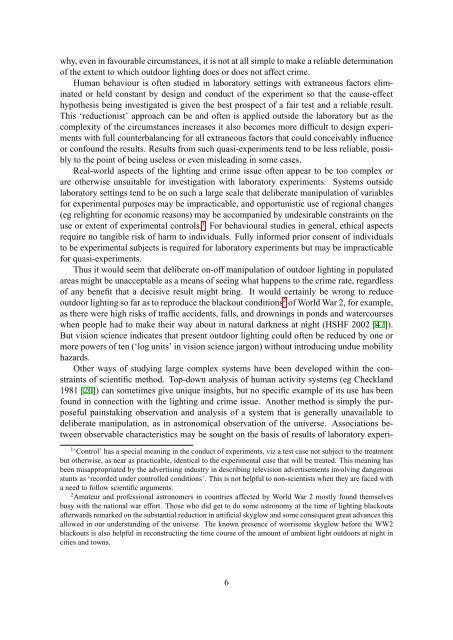outdoor lighting and crime, part 1 - Astronomical Society of Victoria
outdoor lighting and crime, part 1 - Astronomical Society of Victoria
outdoor lighting and crime, part 1 - Astronomical Society of Victoria
Create successful ePaper yourself
Turn your PDF publications into a flip-book with our unique Google optimized e-Paper software.
why, even in favourable circumstances, it is not at all simple to make a reliable determination<br />
<strong>of</strong> the extent to which <strong>outdoor</strong> <strong>lighting</strong> does or does not affect <strong>crime</strong>.<br />
Human behaviour is <strong>of</strong>ten studied in laboratory settings with extraneous factors eliminated<br />
or held constant by design <strong>and</strong> conduct <strong>of</strong> the experiment so that the cause-effect<br />
hypothesis being investigated is given the best prospect <strong>of</strong> a fair test <strong>and</strong> a reliable result.<br />
This ‘reductionist’ approach can be <strong>and</strong> <strong>of</strong>ten is applied outside the laboratory but as the<br />
complexity <strong>of</strong> the circumstances increases it also becomes more difficult to design experiments<br />
with full counterbalancing for all extraneous factors that could conceivably influence<br />
or confound the results. Results from such quasi-experiments tend to be less reliable, possibly<br />
to the point <strong>of</strong> being useless or even misleading in some cases.<br />
Real-world aspects <strong>of</strong> the <strong>lighting</strong> <strong>and</strong> <strong>crime</strong> issue <strong>of</strong>ten appear to be too complex or<br />
are otherwise unsuitable for investigation with laboratory experiments. Systems outside<br />
laboratory settings tend to be on such a large scale that deliberate manipulation <strong>of</strong> variables<br />
for experimental purposes may be impracticable, <strong>and</strong> opportunistic use <strong>of</strong> regional changes<br />
(eg re<strong>lighting</strong> for economic reasons) may be accompanied by undesirable constraints on the<br />
use or extent <strong>of</strong> experimental controls. 1 For behavioural studies in general, ethical aspects<br />
require no tangible risk <strong>of</strong> harm to individuals. Fully informed prior consent <strong>of</strong> individuals<br />
to be experimental subjects is required for laboratory experiments but may be impracticable<br />
for quasi-experiments.<br />
Thus it would seem that deliberate on-<strong>of</strong>f manipulation <strong>of</strong> <strong>outdoor</strong> <strong>lighting</strong> in populated<br />
areas might be unacceptable as a means <strong>of</strong> seeing what happens to the <strong>crime</strong> rate, regardless<br />
<strong>of</strong> any benefit that a decisive result might bring. It would certainly be wrong to reduce<br />
<strong>outdoor</strong> <strong>lighting</strong> so far as to reproduce the blackout conditions 2 <strong>of</strong> World War 2, for example,<br />
as there were high risks <strong>of</strong> traffic accidents, falls, <strong>and</strong> drownings in ponds <strong>and</strong> watercourses<br />
when people had to make their way about in natural darkness at night (HSHF 2002 [47]).<br />
But vision science indicates that present <strong>outdoor</strong> <strong>lighting</strong> could <strong>of</strong>ten be reduced by one or<br />
more powers <strong>of</strong> ten (‘log units’ in vision science jargon) without introducing undue mobility<br />
hazards.<br />
Other ways <strong>of</strong> studying large complex systems have been developed within the constraints<br />
<strong>of</strong> scientific method. Top-down analysis <strong>of</strong> human activity systems (eg Checkl<strong>and</strong><br />
1981 [20]) can sometimes give unique insights, but no specific example <strong>of</strong> its use has been<br />
found in connection with the <strong>lighting</strong> <strong>and</strong> <strong>crime</strong> issue. Another method is simply the purposeful<br />
painstaking observation <strong>and</strong> analysis <strong>of</strong> a system that is generally unavailable to<br />
deliberate manipulation, as in astronomical observation <strong>of</strong> the universe. Associations between<br />
observable characteristics may be sought on the basis <strong>of</strong> results <strong>of</strong> laboratory experi-<br />
1 ‘Control’ has a special meaning in the conduct <strong>of</strong> experiments, viz a test case not subject to the treatment<br />
but otherwise, as near as practicable, identical to the experimental case that will be treated. This meaning has<br />
been misappropriated by the advertising industry in describing television advertisements involving dangerous<br />
stunts as ‘recorded under controlled conditions’. This is not helpful to non-scientists when they are faced with<br />
a need to follow scientific arguments.<br />
2 Amateur <strong>and</strong> pr<strong>of</strong>essional astronomers in countries affected by World War 2 mostly found themselves<br />
busy with the national war effort. Those who did get to do some astronomy at the time <strong>of</strong> <strong>lighting</strong> blackouts<br />
afterwards remarked on the substantial reduction in artificial skyglow <strong>and</strong> some consequent great advances this<br />
allowed in our underst<strong>and</strong>ing <strong>of</strong> the universe. The known presence <strong>of</strong> worrisome skyglow before the WW2<br />
blackouts is also helpful in reconstructing the time course <strong>of</strong> the amount <strong>of</strong> ambient light <strong>outdoor</strong>s at night in<br />
cities <strong>and</strong> towns.<br />
6
















